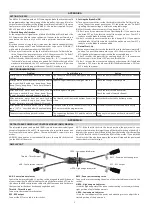
7
Brake Lines
The ”brake lines” are not load carrying suspension lines. They lead from the trailing edge of
the canopy to the main brake lines and run through the pulleys on the D-risers to the brake
handles. A mark on the main brake line indicates the position of the brake handle. This
adjustment, on the one hand, allows sufficient brake to be applied during extreme flying
situations and when landing, while on the other hand, this ensures that brakes are not
permanently applied to the canopy (especially when fully accelerated).
We are convinced it is better to have slightly long brake lines and to fly with a wrap
(one turn of line around the hand) to maximize performance of your glider. The brake line
lengths have been set carefully. This trimming should not be altered.
Risers
The Pasha 7 is equipped with 5 (4+1) risers per side. The A-riser is covered with coloured
webbing, to allow for easy identification. The main suspension loop, on the bottom of the
riser, is covered red. This is where the main karabiner of spreader bar should be hooked
in, which then in turn connects the risers to the harness.
Each of the riser sets of the Pasha 7 has a lockable trimmer. The trim system shortens and
lengthens the B, C and D risers and changes the angle of attack. In neutral position of
normal flight all risers have equal length 39 cm. This neutral position is marked with a white
line on the trimmer straps. When you pull down the trim straps from the white marker
(neutral setting), the D-risers up are shortened of 3 cm. When you open the trims (push the
trim buckles), the D risers are extended by up to 6 cm from the neutral setting.
The risers do not feature speed-system.
Tandem spreader bar
The tandem spreader-bars allows varied attachment possibilities, allowing for the
difference in heights and weights of pilot and passenger. Changing the main attachment
(karabiner - min. strength 24 kN) position can allow for weight difference: the front position
(3) for heavier passengers or if their weights are the same and the back position (4) for
lighter passengers. The passenger weight is always compared to the weight of the pilot!
The rescue system bridle must be connected to main suspension point on the spreader-bar
(3 or 4). It is possible to use a separator karabiner (min. strength 24 kN) for the rescue
system, clipped in to the same loop as the main karabiner. The rescue system bridle must
not be connected only to the pilot's or passenger's harness or to the spreader-bar's hang
points.
WARNING: The karabiners used in position 3 or 4 must be karabiners designed for
tandem flight, which means the minimum strength must be 24kN. (Recommendation
Austrialpin Powerfly, Austrialpin Delta). This applies also to the karabiner used for
the attachment of the rescue system in Position 3 or 4.
Summary of Contents for Pasha 7
Page 1: ...1 ...
Page 29: ...29 LINE PLAN PASHA 7 ...
Page 34: ...34 CHECKS Name Company Date Signature Stamp ...
Page 36: ...36 ...





































